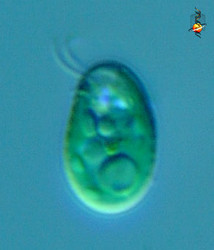Chroomonas | Komma
Kerstin Hoef-Emden and John M. Archibald- Chroomonas (non-monophyletic)
- Komma
Introduction
- Chroomonas described by Hansgirg; type species Chroomonas nordstedtii (freshwater, Hansgirg 1885)
- Komma described by Hill; type species Komma caudata (Hill 1991b)
Characteristics
- Type of biliprotein: PC630 or PC645
- Dimorphism unknown
- Light microscopy: blue-green to blue cells, freshwater and/or marine, one plastid with a pyrenoid, gullet with small opening (usually hardly visible), sometimes with an eyespot close to the pyrenoid
- Ultrastructure: staggered rectangular periplast plates, gullet may be forked, thylakoids traverse the pyrenoid matrix, nucleomorph free in periplastidial space (Santore 1984)
- Komma differs from Chroomonas in cell shape (pointed comma-shaped cells) and periplast (SPC and IPC made of hexagonal plates)
Discussion of Phylogenetic Relationships
Blue-green cryptophytes with hexagonal periplast plates and with a pointed antapex bent towards the ventral side have been separated from Chroomonas (staggered rectangular plates) as the genus Komma. Some Chroomonas species are considered of uncertain status because they contain phycocyanin 630 (absorption maxima at 630 and 583 nm).
In molecular phylogenies, the genus Chroomonas is split up in two clades with Hemiselmis evolving from between the two (Figure 1). The sister clade to Hemiselmis is further subdivided into three clades. By genetic divergence each of the four Chroomonas clades may be considered a separate genus (Hoef-Emden 2008). An examination of the type material of Chroomonas nordstedtii Hansgirg by scanning electron microscopy showed that the current definition of the genus Chroomonas may be wrong. The type material contained elliptical cells with hexagonal periplast plates (Novarino 2003).


Figure 1. Molecular phylogeny of the genera Chroomonas, Hemiselmis and Komma. Maximum likelihood tree inferred from nucleomorph SSU rDNA sequences. PC, phycocyanin; PE, phycoerythrin; scale bar = substitutions per site. © 2008 Kerstin Hoef-Emden
References
Hansgirg A (1885) Anhang zu meiner Abhandlung „Ueber den Polymorphismus der Algen“. Bot. Zentralbl. 23: 229-233
Hill DRA (1991b) Chroomonas and other blue-green cryptomonads. J. Phycol. 27: 133-145
Santore UJ (1984) Some aspects of taxonomy in the Cryptophyceae. New Phytol. 98: 627-646
Hoef-Emden K (2008) Molecular phylogeny of phycocyanin-containing cryptophytes: Evolution of biliproteins and geographical distribution. J. Phycol. 44: 985-993
Novarino G (2003) A companion to the identification of cryptomonad flagellates (Cryptophyceae = Cryptomonadea). Hydrobiologia 502: 225-270
Title Illustrations

| Scientific Name | This may be Chroomonas mesostigmata |
|---|---|
| Location | material from Provasoli-Guillard National Center for Culture of Marine Phytoplankton |
| Source | Chroomonas |
| Source Collection | Micro*scope |
| Image Use |
 This media file is licensed under the Creative Commons Attribution-NonCommercial-ShareAlike License - Version 2.5. This media file is licensed under the Creative Commons Attribution-NonCommercial-ShareAlike License - Version 2.5.
|
| Copyright | © Bob Andersen and D. J. Patterson |
About This Page
This page is being developed as part of the Tree of Life Web Project Protist Diversity Workshop, co-sponsored by the Canadian Institute for Advanced Research (CIFAR) program in Integrated Microbial Biodiversity and the Tula Foundation.
Kerstin Hoef-Emden

Universität zu Köln, Köln, Germany
John M. Archibald

Dalhousie University, Halifax, Nova Scotia, Canada
Correspondence regarding this page should be directed to Kerstin Hoef-Emden at and John M. Archibald at
Page copyright © 2010 Kerstin Hoef-Emden and John M. Archibald
 Page: Tree of Life
Chroomonas | Komma.
Authored by
Kerstin Hoef-Emden and John M. Archibald.
The TEXT of this page is licensed under the
Creative Commons Attribution-NonCommercial License - Version 3.0. Note that images and other media
featured on this page are each governed by their own license, and they may or may not be available
for reuse. Click on an image or a media link to access the media data window, which provides the
relevant licensing information. For the general terms and conditions of ToL material reuse and
redistribution, please see the Tree of Life Copyright
Policies.
Page: Tree of Life
Chroomonas | Komma.
Authored by
Kerstin Hoef-Emden and John M. Archibald.
The TEXT of this page is licensed under the
Creative Commons Attribution-NonCommercial License - Version 3.0. Note that images and other media
featured on this page are each governed by their own license, and they may or may not be available
for reuse. Click on an image or a media link to access the media data window, which provides the
relevant licensing information. For the general terms and conditions of ToL material reuse and
redistribution, please see the Tree of Life Copyright
Policies.
- First online 14 September 2008
- Content changed 14 September 2008
Citing this page:
Hoef-Emden, Kerstin and John M. Archibald. 2008. Chroomonas | Komma. Version 14 September 2008 (under construction). http://tolweb.org/Chroomonas_%7C_Komma/128542/2008.09.14 in The Tree of Life Web Project, http://tolweb.org/








 Go to quick links
Go to quick search
Go to navigation for this section of the ToL site
Go to detailed links for the ToL site
Go to quick links
Go to quick search
Go to navigation for this section of the ToL site
Go to detailed links for the ToL site